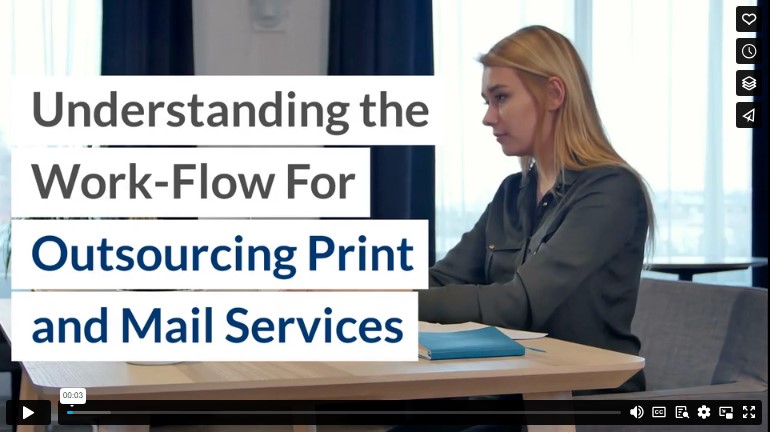Knowing the difference between what to outsource and what you can handle in-house is a sign of a talented business manager. Outsourcing your mail services makes sense and is one of the smartest moves you can make for your business. Relying on professionals to handle a complex and time-consuming process frees you up to do what you do best and will likely save you money.
As technology advances and printing capabilities continue to improve, it rarely makes sense for companies to keep their print and mail services in-house anymore. Printing and mailing companies invest in the latest printing tech with high-speed, black and full-color printers that most businesses can’t realistically justify owning or maintaining in-house. Many companies with a printed marketing campaign have come to rely on these services as an integral part of their process. And due to the high volume these printers turn out, it can add up to significant savings for you and your business.
How Outsourcing Saves Time and Money
The sheer volume print and mail companies produce on a daily basis allows them to streamline their process and focus on efficiency. They can produce your mail for a fraction of what it would cost you to accomplish the same thing in-house. A refined and highly efficient process means that the labor costs associated with your printing job are lower. And, because supplies such as printers, ink, and paper are sourced in bulk, they come at a much lower price per piece. When you add it all together, reducing the price by cents per piece can add up to substantial cost savings for a project with hundreds or thousands of pieces.
The Print-To-Mail Process
As the industry has grown, a standard of operations has developed to keep businesses and printers working together seamlessly. As a marketing professional, you now have the advantage of understanding the process before you ever reach out regarding your next mail project. This standardized workflow may vary slightly between companies but generally outlines what you can expect.
While moving to outsource your mail services may feel unknown and, therefore, slightly overwhelming, you will find it is simple and straightforward. The learning curve is small, and what you have to gain from tapping into the expertise and support is huge. No matter what you are mailing: operational mail (letters, invoices, or bills) or promotional mail (direct mail, newsletters, fliers, or coupons), here is what to expect as you shift your company from in-house to outsourcing your printing and mailing services.
1. Transfer Data
First, you will send your data over to your printing and mailing provider. You can digitally upload your data to your printing service directly via a secure server. Within minutes, they will have access to all the data they need to complete your project.
2. Extract Data
The provider will then sift through your data and extract the pertinent information needed to complete your job. Data will then be filtered into your document and formatted for print.
3. Format
Once the data has been extracted, it is used to create your documents. Professionals will format your mail for print, using your information in conjunction with their knowledge of layout and design. Your printer will format it in an appealing and aesthetically pleasing way that will capture the essence of your brand. Playing with layout, fonts, colors, and wording, experienced printing professionals will make sure that your final product is exactly what you hoped for.
4. Sample Run
The printer will run a test print to ensure your document looks as great on paper as it does on your screen. This allows the printer to ensure that details like margins, print colors, and resolution are up to standards.
5. Print
Now for the fun part. Once everyone is sure that the document looks great, it is time for print. State-of-the-art, high-speed printers will produce your documents within minutes, even in high quantities.
6. Prepare For Mail
After everything is printed and looking great, it is time to get it ready for the mailbox. The printer will use their technologically advanced systems to fold and stuff your envelopes. You can even include things like return mail envelopes or marketing inserts. Your envelopes will be sealed, addressed, metered with postage, and bundled by zip code.
Depending on the type of mailing, your project might need a permit. The mail service will understand all the rules involved with printing for postal regulations and how tweaks to your document may be able to save you money.
7. Mail
Your distributor will package up your mail and transfer it to the USPS. Mail professionals with high business volumes have formed trusted partnerships with the postal service. They can bundle your mailing for quick sorting, helping your project hit mailboxes quickly and efficiently. Before you know it, everyone in your database will receive their mail.
8. Manage Undelivered and Returned Mail
An important last step in the process is managing undelivered and returned mail. You can reduce your undeliverables on future projects by updating your database to eliminate old and incorrect data. Your mail service will work with you to manage these crucial steps with your returned mail.
A great printing and mailing service will keep you updated on every step of the process so that you can feel at ease with the progress made on your project. Outsourcing your next mail project may feel like a chore, but once you’ve gone through the process, you will see precisely how easy it is and wish you had outsourced sooner.
Video
Infographic
Outsourcing your mail services can seem overwhelming, but it’s actually a simple process. Discover what to expect when transitioning from in-house printing and mailing to outsourcing in this infographic.






